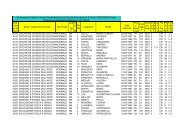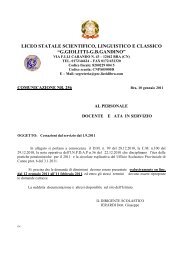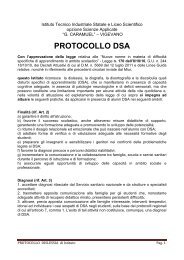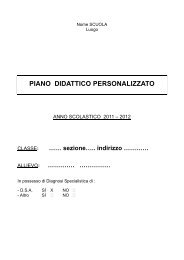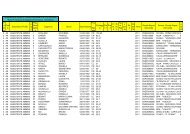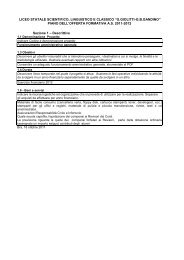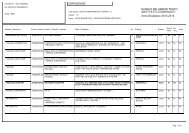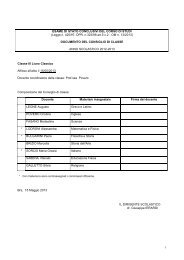Bloom's Taxonomy: Categories in the Cognitive ... - Licei di Bra
Bloom's Taxonomy: Categories in the Cognitive ... - Licei di Bra
Bloom's Taxonomy: Categories in the Cognitive ... - Licei di Bra
Create successful ePaper yourself
Turn your PDF publications into a flip-book with our unique Google optimized e-Paper software.
Knowledge of pr<strong>in</strong>ciples and Types of conflict <strong>in</strong> literature, Newton’s Laws of Motion,generalizationspr<strong>in</strong>ciples of democracyKnowledge of <strong>the</strong>ories, models, and Theory of evolution, economic <strong>the</strong>ories, DNA modelsstructuresProcedural Knowledge—How to do someth<strong>in</strong>gKnowledge of subject-specific skills Procedure for solv<strong>in</strong>g quadratic equations, mix<strong>in</strong>g colorsand algorithmsfor oil pa<strong>in</strong>t<strong>in</strong>g, serv<strong>in</strong>g a volleyballKnowledge of subject-specific Literary criticism, analysis of historical documents,techniques and methodsma<strong>the</strong>matical problem-solv<strong>in</strong>g methodsKnowledge of criteria forMethods appropriate for <strong>di</strong>fferent k<strong>in</strong>ds of experiments,determ<strong>in</strong><strong>in</strong>g when to usestatistical analysis procedures used for <strong>di</strong>fferentappropriate proceduressituations, syllabus guidel<strong>in</strong>es for <strong>di</strong>fferent genres ofwrit<strong>in</strong>gMetacognitive Knowledge—Knowledge of th<strong>in</strong>k<strong>in</strong>g <strong>in</strong> general and your th<strong>in</strong>k<strong>in</strong>g <strong>in</strong>particularStrategic knowledgeWays of memoriz<strong>in</strong>g facts, read<strong>in</strong>g comprehensionstrategies, methods of plann<strong>in</strong>g a Web siteKnowledge about cognitive tasks,<strong>in</strong>clud<strong>in</strong>g appropriate contextualand con<strong>di</strong>tional knowledgeSelf-knowledgeDifferent read<strong>in</strong>g demands of textbooks and novels;th<strong>in</strong>k<strong>in</strong>g ahead when us<strong>in</strong>g an electronic database;<strong>di</strong>fferences between writ<strong>in</strong>g emails and writ<strong>in</strong>g bus<strong>in</strong>esslettersNeed for a <strong>di</strong>agram or chart to understand complexprocesses, better comprehension <strong>in</strong> quiet environments,need to <strong>di</strong>scuss ideas with someone before writ<strong>in</strong>g anessayReferencesAnderson, L. W. & Krathwohl, D. R. (2001). A taxonomy for learn<strong>in</strong>g, teach<strong>in</strong>g, and assess<strong>in</strong>g.New York: Longman.Bloom, B.S., (Ed.). 1956. <strong>Taxonomy</strong> of educational objectives: The classification of educationalgoals: Handbook I, cognitive doma<strong>in</strong>. New York: Longman.Costa, A. L. (Ed.). (2000). Develop<strong>in</strong>g m<strong>in</strong>ds: A resource book for teach<strong>in</strong>g th<strong>in</strong>k<strong>in</strong>g. Alexandria,VA: ASCD.Marzano, R. J. (2000). Design<strong>in</strong>g a new taxonomy of educational objectives. Thousand Oaks,CA: Corw<strong>in</strong> Press.




